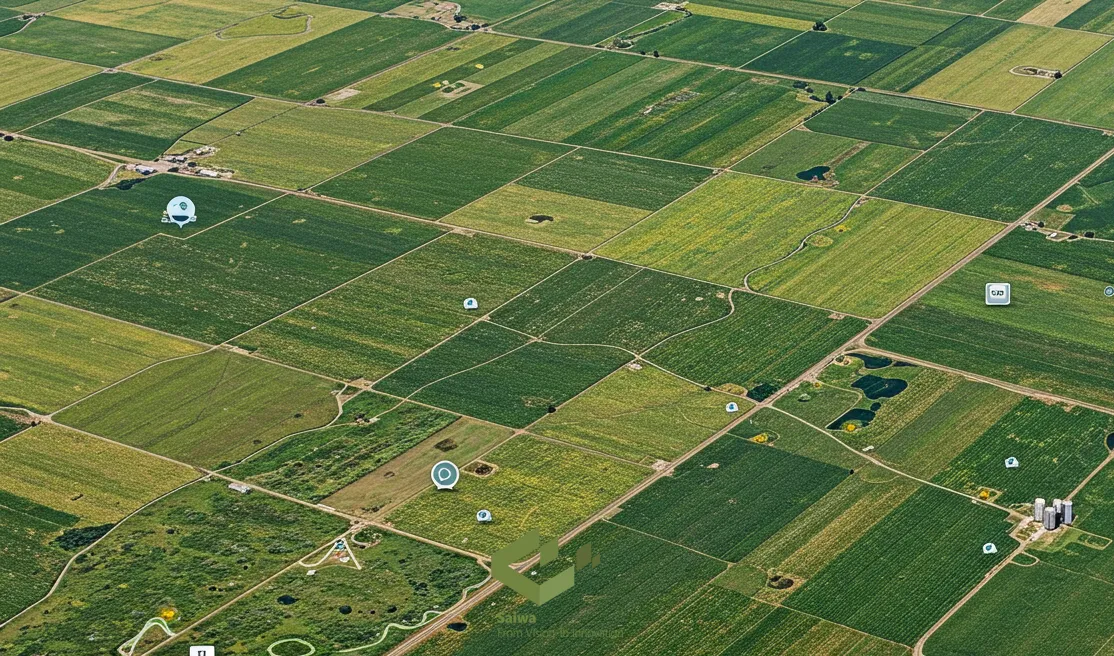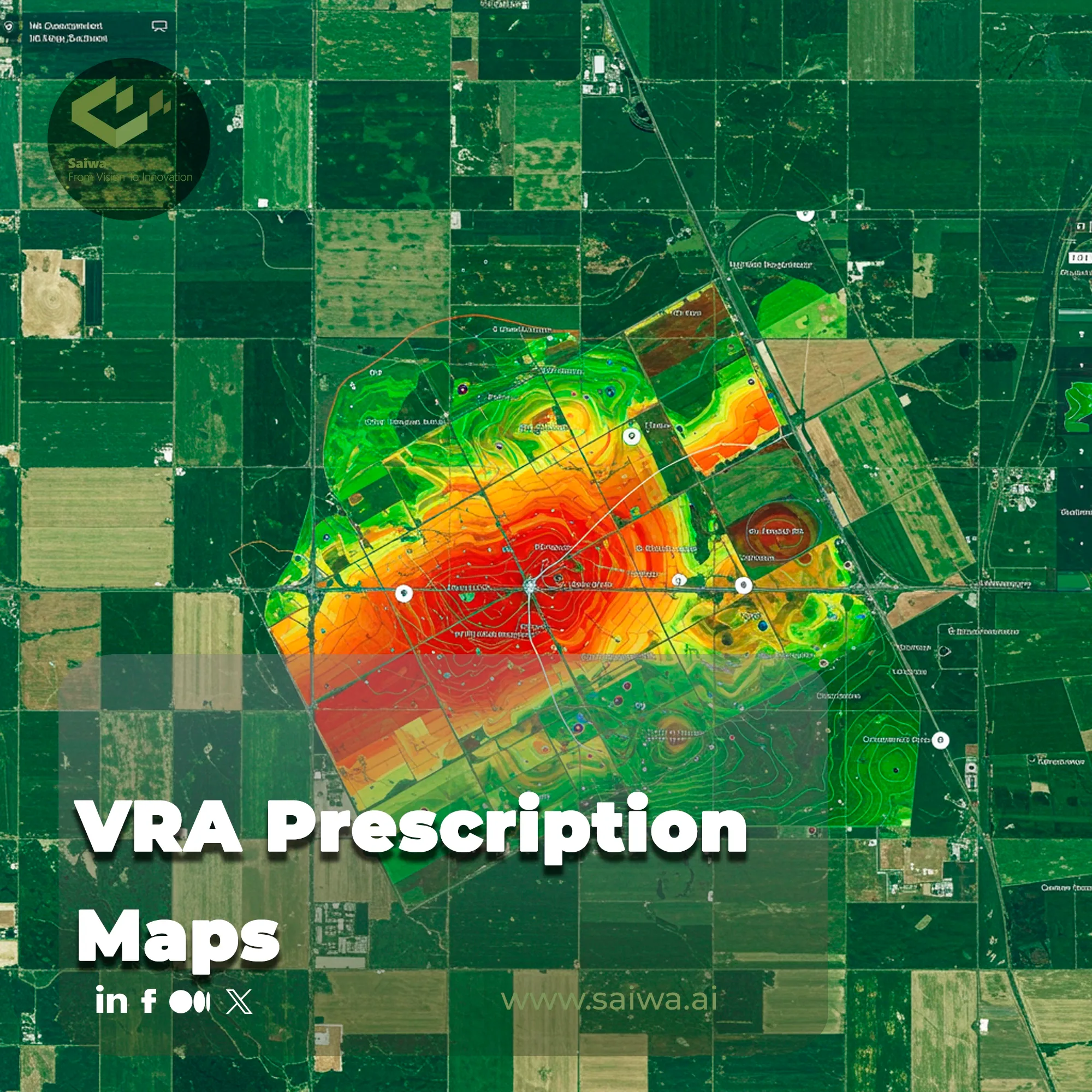How does a tractor or sprayer intelligently adjust its application rate as it moves across a field? It follows a set of digital instructions. These instructions are contained within a VRA Prescription Map—a detailed field plan, derived from data sources like historical yield, soil analysis, and drone imagery, that assigns a specific application rate to each management zone. It acts as the brain for the machinery.
Creating such a sophisticated plan requires powerful analytical tools, which is where Saiwa’s AI platform, Sairone, comes in. This article delves into the essential elements needed to build and utilize these maps effectively.
Data Sources Behind VRA Prescription Maps
The precision of these maps hinges on the quality and diversity of the data inputs that define management zones. Synthesizing these layers is crucial for creating an accurate digital twin of the field. The most effective strategies integrate several key data streams:
Historical Yield and Productivity Zones: Analyzing past harvest data helps identify historically high and low-performing areas, forming the foundational layer for management zones.
Soil Analysis and Nutrient Maps: Grid or zone-based soil sampling provides granular data on nutrient deficiencies or surpluses (e.g., N, P, K) and properties like pH, creating a precise nutrient demand map.
Vegetation Indices (VIs): Derived from satellite or drone imagery, Vegetation Indices analysis like NDVI and NDRE measure crop health, biomass, and stress levels in near real-time, offering a snapshot of plant vigor across the field.
Topography and Terrain Data: Elevation maps are critical as they influence soil moisture, nutrient runoff, and sun exposure, directly impacting crop performance.

Practical Applications of VRA Prescription Maps
This granular data unlocks several high-impact applications on the farm, each targeting a specific operational inefficiency. These applications allow for the surgical placement of inputs, maximizing their effectiveness while minimizing cost and environmental impact.
Fertilizer Application and Nutrient Management
This is the primary use case, where fertilizer is applied at varying rates to match the specific nutrient requirements of each management zone, preventing waste and ensuring optimal crop nutrition.
Seeding Rate Optimization
VRA enables farmers to vary seeding density across a field. Higher rates are used in high-potential zones to maximize yield, while lower rates are used in less productive areas to save on seed costs.
Pesticides and Spot Spraying
Advanced VRA prescription maps are used for targeted pesticide and herbicide application. By integrating AI-powered weed detection, platforms like Sairone can generate maps for spot spraying, where drones only treat infested patches, drastically reducing chemical usage.
Irrigation and Crop Protection
By using indices like the Normalized Difference Moisture Index (NDMI), VRA systems can manage irrigation, delivering more water to zones identified as water-stressed and less to areas with adequate moisture.
Read Also : Machine Learning in Environmental Science - A Sustainable Future
Types of VRA Prescription Maps
VRA maps can be tailored for different operations depending on farm needs: seeding, fertilization, pesticides, irrigation, or soil amendments. Each type focuses on optimizing a specific input, ensuring resources are applied where they are most needed.
1. Seeding / Sowing Maps
Adjust planting density across field zones based on soil fertility, past yields, or crop health, ensuring optimal plant populations and maximizing yield potential.
2. Fertilization Maps
Apply nutrients variably according to soil nutrient levels and crop requirements. This prevents over-application in low-demand areas and ensures high-productivity zones get the nutrients they need.
3. Pesticide & Herbicide Maps
Target specific areas with pest or weed infestations, reducing chemical usage and minimizing environmental impact.
4. Irrigation Maps
Deliver water precisely where it’s needed, conserving resources and avoiding overwatering or water stress in different zones.
5. Soil Amendment Maps
Adjust applications of lime, gypsum, or other soil amendments per zone to optimize pH and soil properties for better crop performance.
By categorizing VRA maps this way, farmers can understand the purpose of each map type before diving into specific operational applications.

Role of AI Advanced Technologies in VRA Mapping
Artificial intelligence elevates VRA from a data-heavy process to a smart, automated workflow. AI algorithms can analyze complex datasets far more effectively than traditional methods, revealing deeper insights for better decision-making.
AI-Derived Prescription Zones
AI models process multiple data layers simultaneously to create dynamic and highly accurate management zones. Instead of relying on a single data point, the AI integrates soil, terrain, and vegetation data for a holistic field view.
Smart Drone Integration
Platforms now seamlessly connect analysis software with hardware, such as XAG spray drones. This ensures that the generated prescription file (e.g., SHP, JSON) is perfectly compatible with the application equipment for flawless execution.
Multi-Sensor Data and Vegetation Indices
AI excels at interpreting data from advanced multispectral sensors (with 15 or more bands), enabling sophisticated crop yield estimation and early stress detection long before it becomes visible to the human eye.
Automated Reporting and Decision Support
Modern AI systems don't just create maps; they interpret them. Features like PIX4Dfields' AI crop growth report synthesize NDVI maps, weather data, and soil conditions to provide farmers with clear, actionable text-based summaries.
Sairone: AI-Powered Insights for Smarter Decisions
At Saiwa, we built Sairone to master this very challenge. Sairone leverages advanced AI to analyze high-resolution drone imagery, delivering precise, actionable insights for weed and pest detection, plant health monitoring, and yield analysis. Instead of just providing raw data, Sairone translates complex visual information into clear, data-driven directives that integrate directly into your precision agriculture workflow, turning insights into action.
Conclusion
The shift from uniform field management to precision agriculture represents a critical evolution in modern farming. By leveraging multiple data sources and the analytical power of AI, VRA prescription technology moves beyond simple mapping to become a comprehensive decision-making tool. This approach not only optimizes input efficiency and boosts yields but also fosters a more sustainable and profitable future for agriculture.
Note: Some visuals on this blog post were generated using AI tools.

